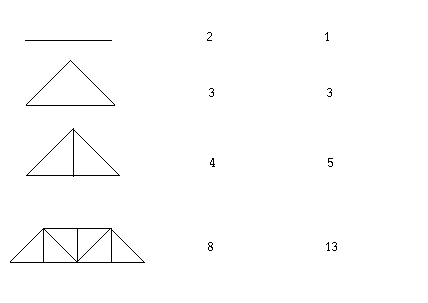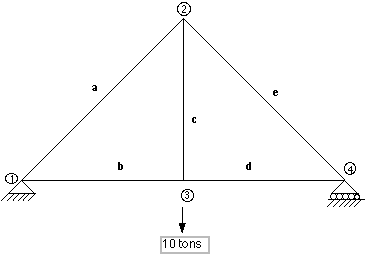BETWEEN THE NUMBERS OF MEMBERS AND JOINTS IN A RIGID STRUCTURE.

The structures above are all statically determinate trusses, meaning that the member forces are determined entirely by the conditions of static equilibrium at the joints. Students may determine the relationship between m (the number of beams) and j (the number of joints) by using their data analysis skills. (Feel free to generate more diagrams to get more data points.) The resulting relationship should be the equation, m = 2j -3.
Let's use a simple example of a bridge (a truss) with 5 pieces and 4 joints in which each acute angle is 45 degrees (see diagram). We want to find the force exerted on each member by a 10 ton truck crossing the bridge.
For each joint to be at equilibrium, the sums of the horizontal forces and the vertical forces on it must be equal to zero. Therefore, each force vector must be broken down into its horizontal and vertical components. (See Background Information) The f's are the stresses in each of the beams.

For example, in the above bridge, joint 2 has members (forces) a , c and e to consider.
Let c = cos 45 and s = sin 45
For the horizontal force:
joint 2: Fx = fa( -cos45) + fc (cos90) + fe( cos45) = 0
Fx = - cfa + cfe = 0
For the vertical force:
joint 2: Fy = -fa(sin45) + - fc(sin90) + - fe(sin45) = 0
Fy = -sfa - fc - sfe = 0
When writing the equations for the forces at each joint, there are some assumptions in this framework to keep in mind. They include:
- joint 1 is fixed; there is no movement, therefore there are no
equations needed for joint 1.
- at joint 3 we are placing a 10 ton truck on the bridge
- at the last joint we need to consider only forces in the x direction because the vertical force is balanced by gravity therefore only horizontal movement is considered.
We set the sums equal to 0 so that the system is at equilibrium.
The following equations are set up under the above conditions, and using our algebra skills we can solve this system of equations. (See Background Information for a review of solving systems of equations.) This determines the force on each member of the truss. In this set of equations, we are solving for the forces (tensions and stresses) fa, fb, fc, fd, fe.
Again, let c = cos 45 and s = sin 45
joint 2: Fx = - cfa + cfe = 0 Fy = - sfa + -fc - sfe = 0 joint 3: Fx = - fb + fd = 0 Fy = fc - 10 = 0 joint 4: Fx = - fe - fd = 0
When solving this system, we find these forces:
fa = -7.0711, fb = 5, fc = 10, fd = 5, fe = -7.0711
USING MATRICES TO SOLVE SYSTEMS OF EQUATIONS
Once your system of equations has been set up from the diagram of the bridge and the forces on it, you may wish to let a program like MATLAB solve it, rather than trying to solve it by hand. To use MATLAB, you must understand the role of matrices in systems of equations. Let's consider the equations in the previous example.
Let angle = 45 or pi/4, c = cos(angle) and s = sin(angle)
Therefore, the equations become:
-cfa +0 +0 +0 +cfe = 0 -sfa +0 -fc +0 -sfe = 0 +0 -fb +0 +fd +0 = 0 +0 +0 +fc +0 +0 = 10 +0 +0 +0 -fd -cfe = 0
Notice that I have lined up the variables in columns, placing zeros where variables are missing from an equation.
Note: It would be very helpful to the student to use grid paper to enter the coefficients in matrix format. For example, see the grid below. If one number is out of place, the solution will be invalid.
| -cfa | 0 | 0 | 0 | cfe | = | 0 | -sfa | 0 | -fc | 0 | -sfe | = | 0 | 0 | -fb | 0 | fd | 0 | = | 0 | 0 | 0 | fc | 0 | 0 | = | 10 | 0 | 0 | 0 | -fd | -cfe | = | 0 |
Now, I will break up the equations into their matrix form AX = B, where A will be the matrix of coefficients, X will be the matrix of unknowns, and B will be the matrix of constants.
 |
 |
 |
In matrix multiplication, each row of A is multiplied by a column of X to
generate a value in B. For example, multiplying row 1 of A by X results in
the first entry of B:
- cfa + 0 + 0 + 0 + cfe = 0In algebra, 3x = 5 can be solved by multiplying both sides of the equation by 1/3, the inverse of 3, so that x = (inverse of 3)*5 = (1/3)*5 = 5/3. In matrix algebra, if AX = B, X = (inverse of A) * B. Finding the inverse of a matrix by hand is a difficult task, but a program like MATLAB will do it for us.
It should be noted that finding the inverse of a matrix is computationally intensive. Therefore, the better method of solving a system of equations is to use Gaussian Elimination, a linear algebra technique which is similar to the method by which a student would solve a system of equations by hand. MATLAB may also be used to perform Gaussian Elimination.
Continue to the MATLAB Student Exercises or back to the Bridge Model Main Page.